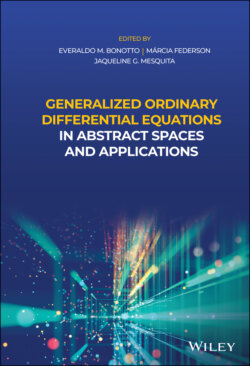Читать книгу Generalized Ordinary Differential Equations in Abstract Spaces and Applications - Группа авторов - Страница 20
1.3.1 Definitions
ОглавлениеWe start by recalling some definitions of vector integrals in the sense of J. Kurzweil and R. Henstock. At first, we need some auxiliary concepts, namely tagged division, gauge, and ‐fine tagged division.
Definition 1.35: Let be a compact interval.
1 Any set of point‐interval pairs such that and for , is called a tagged division of . In this case, we write , where denotes the set of all tagged divisions of .
2 Any subset of a tagged division of is a tagged partial division of and, in this case, we write .
3 A gauge on a set is any function . Given a gauge on , we say that is a ‐fine tagged partial division, whenever for , that is,whenever
Before presenting the definition of any integral based on Riemannian sums concerning ‐fine tagged divisions of an interval , we bring up an important result which guarantees the existence of a ‐fine tagged division for a given gauge . This result is known as Cousin Lemma, and a proof of it can be found in [120, Theorem 4.1].
Lemma 1.36 (Cousin Lemma): Given a gauge of , there exists a ‐fine tagged division of .
Definition 1.37: We say that is Kurzweil ‐integrable (or Kurzweil integrable with respect to ), if there exists such that for every , there is a gauge on such that for every ‐fine ,
In this case, we write and .
Analogously, we define the Kurzweil integral of with respect to a function .
Definition 1.38: We say that is Kurzweil integrable (or Kurzweil integrable with respect to ), if there exists such that given , there is a gauge on such that
whenever is ‐fine. In this case, we write and .
Suppose the Kurzweil vector integral exists. Then, we define
An analogous consideration holds for the Kurzweil vector integral .
If the gauge in the definition of is a constant function, then we obtain the Riemann–Stieltjes integral , and we write . Similarly, when we consider only constant gauges in the definition of , we obtain the Riemann–Stieltjes integral , and we write . Hence, if we denote by the set of all functions which are Riemann integrable with respect to and by the set of all functions which are Riemann integrable with respect to , then we have
The next very important remark concerns the terminology we adopt from now on in this book concerning Kurzweil vector integrals given by Definitions 1.37 and 1.38.
Remark 1.39: We refer to the vector integrals from Definitions 1.37 and 1.38, namely,
where and , as Perron–Stieltjes integrals. For the particular case where is the identity in and , we refer to the integral
simply as a Perron integral. Our choice to use this terminology is due to the fact that, in Chapter 2, we deal with a more general definition of the Kurzweil integral which encompasses all integrals presented here. Moreover, since the same notation for the integrals
are used for Riemann–Stieltjes integrals, we will specify which integral we are dealing with whenever there is possibility for an ambiguous interpretation.
The vector integral of Henstock, which we define in the sequel, is more restrictive than the Kurzweil vector integral for integrands taking values in infinite dimensional Banach spaces.
Again, consider functions and .
Definition 1.40: We say that is Henstock ‐integrable (or Henstock variationally integrable with respect to ), if there exists a function (called the associate function of ) such that for every , there is a gauge on such that for every ‐fine ,
We write in this case.
In an analogous way, we define the Henstock ‐integrability of .
Definition 1.41: We say that is Henstock ‐integrable (or Henstock variationally integrable with respect to ), if there exists a function (called the associate function of ) such that for every , there is a gauge on such that for every ‐fine ,
We write in this case.
Next, we define indefinite vector integrals.
